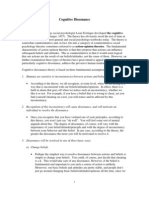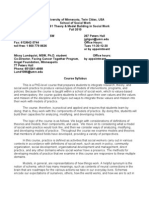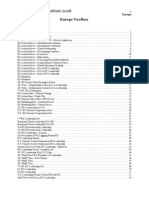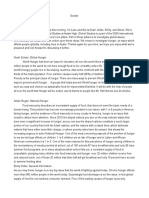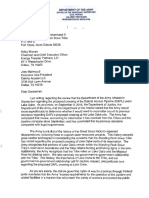Community Psychology
Community Psychology
Uploaded by
Killiam WettlerCopyright:
Available Formats
Community Psychology
Community Psychology
Uploaded by
Killiam WettlerOriginal Description:
Copyright
Available Formats
Share this document
Did you find this document useful?
Is this content inappropriate?
Copyright:
Available Formats
Community Psychology
Community Psychology
Uploaded by
Killiam WettlerCopyright:
Available Formats
COMMUNITY PSYCHOLOGY Seeks solutions for social problems through research and action Studies effects of social and
environmental factors on behavior as behavior is expressed at the individual, group, community, organizational, institutional and societal levels Studies processes that create and maintain these problems Focuses on developing interventions to improve overall health of community by changing processes that create problems Integration of research and action to enhance quality of individual and community lives Participant Conceptualizer- community psychologist, actively involved in community process while attempting to explain it GUIDING PRINCIPLES Welfare of individual and family, community, diversity, justice, participation, collaboration, integrity and empirical grounding Must emphasize engagement with community itself, not merely observing it Values- clarify choices, question dominant views, identify incongruence between actions and current values, understanding community requires comprehension of values, values unify community Wellness- physical and psychology health and attainment of goals Collective Wellness- health of community defined by justice and empowerment Community- perception of belongingness, interdependence and mutual commitment Diversity- recognition of variety of social identities Justice- fair, equitable allocation of resources, opportunities, obligations and power Distributive Justice- allocation of resources Procedural Justice- representative in decision making Collaboration- working with, not upon, community members Empirical Evidence0 base action on tested evidence for effectiveness Prevention and Promotion0 reduce future likelihood of problems Consultation- promote satisfaction and effectiveness of services Alternative Settings- provide alternative treatment areas Community Development- help citizens organize to identify and solve issues Participatory Research0 researchers and citizens collaborate to solve issues Policy Research0 research to inform decision makers PARADIGM Assumptions, values, theoretical perspectives that define the questions to be asked and solutions to be considered Shifts occur when current assumptions and perspectives are challenged and alternative definitions of problems and corresponding solutions are considered Shift away from person-centered to ecological-centered, from interventions that change people to changing context, from remedying deficits to enhancing competence and empowerment HISTORY Social Movements- civil rights movement for justice, diversity and participation, advocating local action War on Poverty- provide safety from poverty through welfare, unemployment benefits, etc. Deinstitutionalization- Advances in psychotropic medication reduced dependence upon medication Hospitalization failed to prepare individuals for independent living Relocation of mentally ill to criminal justice system
Community Health Center Movements- community lodges developed to create mutually supportive communities Identify conditions that inhibit mental health and change them through social action
COMMUNITY Geographically defined interdependent relations Reference group of shared identity, ideology and experience Complex social system with defined hierarchical structure Service area of particular activity Membership- sense of personal investment and belonging Boundaries- what includes and excludes members Common Symbols- define boundaries and identify members Emotional Safety- sense of security and shared emotions Personal Investment- long-term commitment Identification- accepted by other members Integration- shared values and exchange of resources Neighboring- informal contacts and assistance among neighbors Place Attachment- emotional bonding attached to environment Citizen Participation- having influence in community decisions Social Support- help by others to promote coping with stress Social Capital- connections among individuals, social networks and norms of reciprocity and trustworthiness Bonding- maintaining social-emotional ties within groups of similar persons through support and mutual commitment Bridging- creating bonds between groups that have diverse experiences BIAS Cultural background, experience and bias shape assumptions and responses to problems Context Minimization Error- ignoring importance of context Context- environment within which an individual lives Fundamental Attribution Error- tendency of observers to overestimate individual characteristics Persons change contexts and contexts shape people Questionable if individuals without experience of social problems should attempt to solve them CHANGE First Order Change- alters, rearranges, or replaces individual members of a group Second Order Change- changing relationships between individuals Bottom-Up- originates among citizens, reflects attempts to assert control Top-Down- originates among professionals, reflects attempts to preserve power structure Progressive governments concerned with optimism and change, conservatives less so SOCIAL PROBLEM All problems occur in a social context and are to varying degrees social issues Individual variables determine who is affected by stress but society creates stress Social problem is bound by time, place and context Represents particular construction of reality Must be periodically redefined, underlying assumptions re-examined, thus expanding possible solutions
Current solutions ineffective despite time, money and effort Assumptions are flawed and requires paradigm shift Simplistic solutions perpetuation problems by false impressions and unintended consequences Single Standard Assumption- assumes individuals operate according to same standards but problems are difficult because people adapt to accept them Pragmatism- rely on simplest, most understandable and agreeable solution Also relies on assumptions of individualism, rationality, problemizing, over-extension, and generalization LEVELS OF ANALYSIS Individual-single person Group- Collection of individuals Community-large group with a shared identity Organization- communities with a purpose to activity Institution- abstract purposes of organizations Society- political and cultural organization of institutional services ERROR OF LOGICAL TYPING Solutions to social problems not targeted at appropriate level Error produces iatrogenic effects Divided into levels of individual, group, community, organization, institution, society IATROGENIC EFFECTS Government intervention may alienate community response resources Transfer of federal to local allows easier access to research Lack of trust in government has fostered communal resources Budget limitations may foster growth of alternative solutions Globalization- centralizing effects of market capitalism LAW OF AROUSAL (YERKES-DODSON) Relationship between efficiency and performance is an inverted U-shape with inefficient performance at extreme levels of arousal Optimal performance requires optimum arousal for specific task Level of arousal needed to garner support differs from level needed to develop solution Best way to control over-arousal is to simplify it into smaller issues Small issues are easier to solve and manage with greater flexibility Politically less threatening and easier to tolerate Small issues are more effective in the aggregate COMPREHENSIVE APPROACH (RAPPAPORT) Define problem as it is currently Identify and evaluate current assumptions Redefine problem and look for higher level contributions Conceptualize multiple possible solutions and target several levels or organization simultaneously Concepts match complexity of problem, avoids simplistic solutions Multiple simultaneous solutions, possibility of finding effective long-term solutions Too complex, challenges status quo, divisive, political change can result in loss of impetus for change SMALL WINS ALTERNATIVE (WEIK)
Better at diagnosing problems than solving Efforts to address social problems often hampered by high emotional arousal Magnitude of social problem scaled upward to mobilize action, occurs at expense of clear thought Limits risk of overwhelming, controls resistance, small success could build into larger aggregate change Solutions are achievable in short time with fewer resources Oversimplifies, compromise solutions risks iatrogenic effects Assumes small wins will aggregate Time, resources and attention tend to quickly shift once small changes are made INTEGRATION Integrate the concepts of Rappaport with the practice of Weik Divergent Reasoning- identify multiple truths in opposing perspectives through dialogue, not debate PRINCIPLES OF SOCIAL SETTINGS (KELLY) Interdependence- mutual influence of subsystems, interventions with wide effects Cycling- cycle resources according to values, differ not only in kind but use Interventions seek to not only provide additional resources but instruct for better use Adaptation-all settings make demands for adaptation, behavior in setting are partially products of adaptation Changes in setting can be understood as responses to demands for adaptations to changing political, economic and social pressures Succession- orderly, directional, predictable process of community change Results from the physical or emotional modification of the environment by the community or external forces Changes culminate in the establishment of new ecosystem BEHAVIOR SETTINGS (BARKER) Behavior settings are naturally occurring spatial and temporal features of environments that shape behavior independent of individual residents Behavior characterize settings , settings vary in the degree to which they exert these effects Behavior settings are discrete locations that impact behavior because of size, function, availability of roles and the rules that govern behavior Settings generate own maintenance forces upon individuals acting within them Manning- relationship between number of roles and level of role demands and availability of persons to meet demands and meet roles Undermanned- significant imbalance between role demand and responsibilities and people to fill the need, push inhabitants towards greater participation and to assume more responsibility Morale high, risk of burnout, greater tolerance Overmanned- people exceed availability of meaningful roles Setting more stable in long term but risks alienation Strong rules imposed to ensure respect for hierarchy Small cliques likely to form, tolerance is low Behavior setting is descriptive but fails to consider the person-environment fit Program Circuits- agenda for a meeting, guides the standing behavior pattern Goal Circuits- satisfy goals of individuals Deviation-Countering Circuits- training individuals for roles in the behavior setting and correcting their behavior to improve role performance Vetoing Circuits- occur when individuals are excluded from behavior setting
SOCIAL CLIMATE ANALYSIS (MOOS) Social Climate- product of residents subjective impressions or cognitive-affective map of the setting Impact of setting on behavior is mediated by social cognitions about the setting Physical- size, population density, resources Group- mix of people in setting Organizational Structure- size, complexity Reinforcement- consequences of behavior Organizational Climate- rules, decisions, pathways Social Climate- subjective impressions Relationship Dimension- degree of involvement, affiliation, support, cohesion Personal Growth Dimension- degree of autonomy, achievement System Change Dimension- structure, clarity or expectations, control Outcomes can be changed by changing setting aspects that contribute to their behavior Greater stress in competitive orientation, time pressure, restrictive organization and control, lack of personal choice, ambiguous rules ROLE THEORY (SARBIN) Useful in understanding problems of adaptation and in designing interventions other than those that are person-centered Environments or social settings and understandable as a series of differentiated ecologies or social niches within which people correctly locate them Roles help define who we are in relation to others Violations of roles result in conflict Social rules may prevent access to roles for individuals Improved access can be achieved by changing rules by changing laws, by conflict confrontation or by changing incentives to open up opportunities Behavior understood as function of role as well as individual attitudes Can be coercive on behavior as people try to fulfill social role Loss of meaningful roles is detrimental to well-being Conflicted roles constrain behavior or produce contradictory behavior How available are rules, who has access, what determines access Status- position in social structure Ascribed- biosocial based Achieved- effort based Value- positive or negative evaluation of performance of role Involvement- amount of time and energy in performing role Roles with high achieved status involve considerable status Minimum role performance is sufficient to garner benefits High ascribed status carry little or no benefit Minimum performance of these roles results in little status Can suffer from role stress, role conflict or role overload Can have degraded social identities, may function despite this Social relationships often limited to those of similar roles Interventions should include increasing variety of roles, positive self-esteem Critical factor is number of available roles compared to individuals
You might also like
- The Personal Development Group. The Student's GuideDocument13 pagesThe Personal Development Group. The Student's GuideScottNo ratings yet
- Spiritual Diversity in Social Work Practice The Heart of Helping, Second Edition (PDFDrive)Document468 pagesSpiritual Diversity in Social Work Practice The Heart of Helping, Second Edition (PDFDrive)Zahra AdhaNo ratings yet
- The Life Model of Social Work Practice: Advances in Theory and Practice (Third Edition)From EverandThe Life Model of Social Work Practice: Advances in Theory and Practice (Third Edition)No ratings yet
- Decision Making Using MBTIDocument3 pagesDecision Making Using MBTISalsabilla HumairaNo ratings yet
- Community Psychology - 2022Document19 pagesCommunity Psychology - 2022utkarsha mishraNo ratings yet
- Social Diagnosis PDFDocument520 pagesSocial Diagnosis PDFraazenNo ratings yet
- Chapter 8 and 9Document32 pagesChapter 8 and 9melodyfathi0% (1)
- Math 15Document16 pagesMath 15Killiam WettlerNo ratings yet
- Interaction Total Rows Columns WithinDocument21 pagesInteraction Total Rows Columns WithinKilliam Wettler50% (2)
- Emcee ScriptDocument3 pagesEmcee ScriptEdpher Leo Sindol100% (8)
- Ecological Social WorkDocument12 pagesEcological Social WorkSreenivasa Reddy DNo ratings yet
- Evaluation Foundations Revisited: Cultivating a Life of the Mind for PracticeFrom EverandEvaluation Foundations Revisited: Cultivating a Life of the Mind for PracticeNo ratings yet
- Community PsychologyDocument7 pagesCommunity Psychologysimango_tariroNo ratings yet
- Community PsychologyDocument20 pagesCommunity PsychologyMaePornelaGomezNo ratings yet
- Course Information Uts Converted Converted 1Document7 pagesCourse Information Uts Converted Converted 1Jhunuarae AlonzoNo ratings yet
- Community PsychologyDocument11 pagesCommunity PsychologyReyalyn AntonioNo ratings yet
- Chapter1 - Overview of Contemporary Counseling ModelsDocument2 pagesChapter1 - Overview of Contemporary Counseling ModelsSCi RNo ratings yet
- The Role of The Family Context in Development of Emotion RegulationDocument26 pagesThe Role of The Family Context in Development of Emotion RegulationAna María Villamil Camacho100% (1)
- Human Values: Psychological Basis of BehaviourDocument13 pagesHuman Values: Psychological Basis of BehaviourITISHA JAIN100% (2)
- 9 - The Oxford Handbook of Qualitative Research by Patricia Leavy-162-185Document24 pages9 - The Oxford Handbook of Qualitative Research by Patricia Leavy-162-185mayara.gomesNo ratings yet
- Feminist Therapy Code of Ethics Revised 1999Document4 pagesFeminist Therapy Code of Ethics Revised 1999api-251536652No ratings yet
- Meaning: Dinated ManagementDocument17 pagesMeaning: Dinated ManagementSreejith Madhav100% (1)
- Feminist TherapyDocument32 pagesFeminist TherapyRozenn AntogopNo ratings yet
- The Social Work "Helping" ProcessDocument17 pagesThe Social Work "Helping" ProcessKyle Moon100% (2)
- Chapter 15 Narrative TherapyDocument23 pagesChapter 15 Narrative Therapylithakazi01No ratings yet
- Social Work's Changing IdentitiesDocument14 pagesSocial Work's Changing IdentitiesMalcolm PayneNo ratings yet
- 2 Person Centred TherapyDocument15 pages2 Person Centred TherapyNadia CupsaNo ratings yet
- Problem Solving in Clinical Social WorkDocument7 pagesProblem Solving in Clinical Social Workडेल एलन शूरवीरोंNo ratings yet
- SocialWorkDictionary Booklet Updated 2012 Oct23Document40 pagesSocialWorkDictionary Booklet Updated 2012 Oct23Grace Marie100% (1)
- An Optimistic View On PsychologyDocument11 pagesAn Optimistic View On PsychologyLiliana GomezNo ratings yet
- Ethical Theories in Health and Social CareDocument5 pagesEthical Theories in Health and Social CareRameeza AbdullahNo ratings yet
- Social 11 4287056252Document86 pagesSocial 11 4287056252smrutimehtaNo ratings yet
- 02 Social Perception and AttributionDocument6 pages02 Social Perception and AttributionsunnyNo ratings yet
- Street Level Bureaucracy, Social Work and The (Exaggerated) ...Document25 pagesStreet Level Bureaucracy, Social Work and The (Exaggerated) ...XXXXXXXXXXXNo ratings yet
- Topic 9 Counselling in A Multicultural SocietyDocument35 pagesTopic 9 Counselling in A Multicultural SocietyQuen MieraNo ratings yet
- Appreciative Supervision in Social WorkDocument16 pagesAppreciative Supervision in Social Workroxanel_84No ratings yet
- Social Work Education 1Document30 pagesSocial Work Education 1MEHUL RABARINo ratings yet
- Attachment Theory ChesterRepDocument28 pagesAttachment Theory ChesterRepmed-psy-01-23No ratings yet
- Week 3 THEORIES OF SOCIOLOGYDocument15 pagesWeek 3 THEORIES OF SOCIOLOGYLillian KobusingeNo ratings yet
- Gestalt Therapy: Gestalt Therapy Is An Existential/experiential Form of Psychotherapy That Emphasizes PersonalDocument11 pagesGestalt Therapy: Gestalt Therapy Is An Existential/experiential Form of Psychotherapy That Emphasizes PersonalElga Gauzia100% (1)
- The Role of Culture in Suicide Prevention in AdolescentsDocument6 pagesThe Role of Culture in Suicide Prevention in Adolescentskrivavi12No ratings yet
- Running Header: ADOLESCENT DEVELOPMENT 1Document28 pagesRunning Header: ADOLESCENT DEVELOPMENT 1Coleen AndreaNo ratings yet
- Cognitive Dissonance TheoryDocument3 pagesCognitive Dissonance TheoryJelena RodicNo ratings yet
- Role of Community Psychologist in ViolenceDocument6 pagesRole of Community Psychologist in ViolenceMichelle JohnsonNo ratings yet
- Social Group Work TheoriesDocument8 pagesSocial Group Work TheoriesjubilleeNo ratings yet
- An Introduction To A Postmodern ApproachDocument8 pagesAn Introduction To A Postmodern ApproachWuLand'z AlbuzblackmOonNo ratings yet
- Clinical Dillemas SCATURO McPEAKDocument12 pagesClinical Dillemas SCATURO McPEAKMardan IulianNo ratings yet
- What Is Feminist ResearchDocument12 pagesWhat Is Feminist ResearchCrista AbreraNo ratings yet
- Theory Use in Counseling Practice: Current Trends: Int J Adv CounsellingDocument16 pagesTheory Use in Counseling Practice: Current Trends: Int J Adv CounsellingWastiti AdiningrumNo ratings yet
- Interpersonal Psychotherapy: Introduction and OverviewDocument22 pagesInterpersonal Psychotherapy: Introduction and OverviewRonald Bartolome100% (1)
- Douglas Long & Steven Hayes - Acceptance, Mindfulness and Cognitive Reappraisal As Predictors of Depression and Quality of Life in EducatorsDocument7 pagesDouglas Long & Steven Hayes - Acceptance, Mindfulness and Cognitive Reappraisal As Predictors of Depression and Quality of Life in EducatorsIrving Pérez MéndezNo ratings yet
- Theory & Model-Building in Social Work, A Course SyllabusDocument17 pagesTheory & Model-Building in Social Work, A Course SyllabusJane Gilgun100% (3)
- Personality and Self ConceptDocument16 pagesPersonality and Self ConceptPrabha Rpai100% (1)
- Interview With Shelley TaylorDocument9 pagesInterview With Shelley TaylornirutnaraNo ratings yet
- Contracting For Group SupervisionDocument5 pagesContracting For Group Supervisionapi-626136134No ratings yet
- Reality TherapyDocument14 pagesReality TherapyHerc SabasNo ratings yet
- FeministCounseling 1Document22 pagesFeministCounseling 1Anne WongNo ratings yet
- Supervising The Supervisors What Support Do FirstDocument12 pagesSupervising The Supervisors What Support Do First2277vaishnavi yadavNo ratings yet
- Zettle & Rains 1989Document10 pagesZettle & Rains 1989Gab GoodNo ratings yet
- Nelson Jones 2e CH 01Document11 pagesNelson Jones 2e CH 01Lee Cheah EuNo ratings yet
- Positive PsyDocument14 pagesPositive PsySuvrata Dahiya PilaniaNo ratings yet
- The Foundations of Flourishing: Joseph CiarrochiDocument4 pagesThe Foundations of Flourishing: Joseph CiarrochiJ0SUJ0SUNo ratings yet
- Against Magic System RulesDocument7 pagesAgainst Magic System RulesKilliam WettlerNo ratings yet
- Afrofuturism ResistanceDocument68 pagesAfrofuturism ResistanceKilliam Wettler100% (1)
- 100BFIRSTDocument7 pages100BFIRSTKilliam WettlerNo ratings yet
- Real Answers To The Meaning of Life and Finding HappinessDocument70 pagesReal Answers To The Meaning of Life and Finding HappinessKilliam WettlerNo ratings yet
- Clarifying The ConceptsDocument22 pagesClarifying The ConceptsKilliam WettlerNo ratings yet
- Coaching in Human ResourceDocument21 pagesCoaching in Human Resourcesya_ezNo ratings yet
- Ch3 Green Engineering Textbook 508Document7 pagesCh3 Green Engineering Textbook 508Arslan AzharNo ratings yet
- Note For AAB 23-06-2023Document2 pagesNote For AAB 23-06-2023Durgeswara Rao VangipurapuNo ratings yet
- Viewpoint Comparison EssayDocument5 pagesViewpoint Comparison EssayVictor BarbosaNo ratings yet
- Essay Food ProductionDocument1 pageEssay Food ProductionIsaMulderNo ratings yet
- Mcclelland'S Theory of NeedsDocument2 pagesMcclelland'S Theory of NeedsmasoodNo ratings yet
- Europe Toolbox - ScholarsDocument100 pagesEurope Toolbox - ScholarsAffNeg.ComNo ratings yet
- DHL Ion Casestudy JaguarDocument2 pagesDHL Ion Casestudy Jaguarmayur45No ratings yet
- IsaMill Carbon Presentation BHPB Nov 07Document56 pagesIsaMill Carbon Presentation BHPB Nov 07Manuel Leiva CerdaNo ratings yet
- The Effect of Sustainability Reporting On Financial Performance An Empirical Study Using Listed CompaniesDocument24 pagesThe Effect of Sustainability Reporting On Financial Performance An Empirical Study Using Listed CompaniesAprilian TsalatsaNo ratings yet
- Affective Spaces, Melancholic Objects: Ruination and The Production of Anthropological Knowledge Navaro YashinDocument19 pagesAffective Spaces, Melancholic Objects: Ruination and The Production of Anthropological Knowledge Navaro YashinszymelNo ratings yet
- Ministry of Rural Development, Govt of India: Mission Antyodaya Survey 2019Document159 pagesMinistry of Rural Development, Govt of India: Mission Antyodaya Survey 2019Chenaai SchoolNo ratings yet
- Smart Partnership Summit (Allen Young) (Revision 2) 030814Document3 pagesSmart Partnership Summit (Allen Young) (Revision 2) 030814LCNo ratings yet
- Why I Should Be Tolerant (Sunita Narain)Document198 pagesWhy I Should Be Tolerant (Sunita Narain)chandraippa2No ratings yet
- DC Group ScriptDocument2 pagesDC Group Scriptapi-314078334No ratings yet
- Infosys LeadershipDocument16 pagesInfosys LeadershipankurmanuNo ratings yet
- Usace LetterDocument2 pagesUsace LetterRob PortNo ratings yet
- P&G PresentationDocument25 pagesP&G PresentationKarishma BediNo ratings yet
- CHAPTER 5 - Marketing EnvironmentDocument13 pagesCHAPTER 5 - Marketing EnvironmentHairizal HarunNo ratings yet
- Eusa Reg 600 2 PDFDocument2 pagesEusa Reg 600 2 PDFMicheleNo ratings yet
- Brochure pro-OGM de Jeffrey VitaleDocument3 pagesBrochure pro-OGM de Jeffrey VitalejeuneafriqueNo ratings yet
- Bibliografia, para El Diseño de Preesas, Diques y Estructuras HidraulicasDocument2 pagesBibliografia, para El Diseño de Preesas, Diques y Estructuras HidraulicasMiguel Felipe PovedaNo ratings yet
- Rule Curves For Kabini Reservoir Drawn Using Historic ReleasesDocument5 pagesRule Curves For Kabini Reservoir Drawn Using Historic ReleasesVageesha Shantha Veerabhadra SwamyNo ratings yet
- "Water Audit and Conservation in Industries": Online Training OnDocument1 page"Water Audit and Conservation in Industries": Online Training Onanandm21No ratings yet
- Ethical Considerations of Global Biofuels ProductionDocument10 pagesEthical Considerations of Global Biofuels ProductionCarlos RymerNo ratings yet
- How Do Generational Differences Impact Organizations and TeamsDocument7 pagesHow Do Generational Differences Impact Organizations and TeamsAnjali Kumari100% (1)
- ECOSOC - Background PaperDocument8 pagesECOSOC - Background PaperAna Paula Marin MonteroNo ratings yet
- Alms BazarDocument300 pagesAlms BazarNaveen K. JindalNo ratings yet
- SustainUS Policy Briefs: Part 1Document7 pagesSustainUS Policy Briefs: Part 1olimarmaisonetNo ratings yet










































